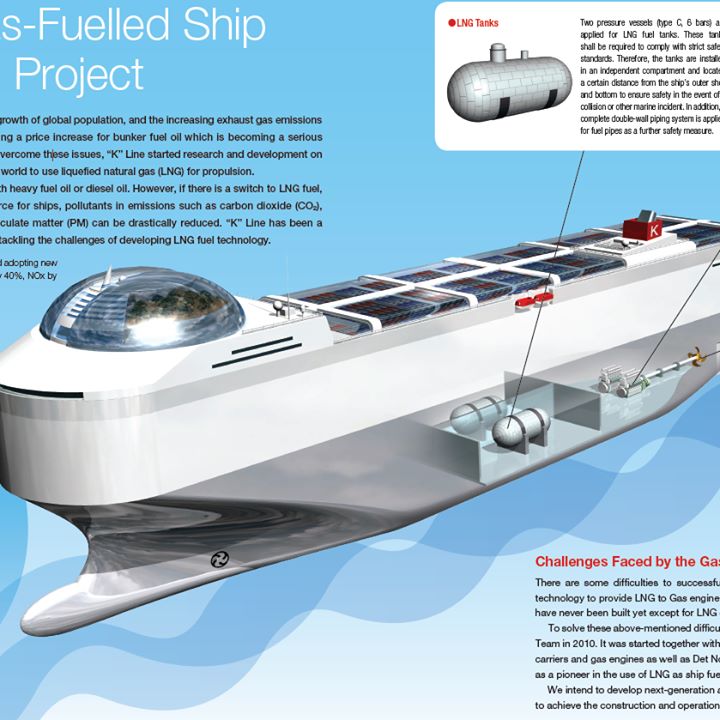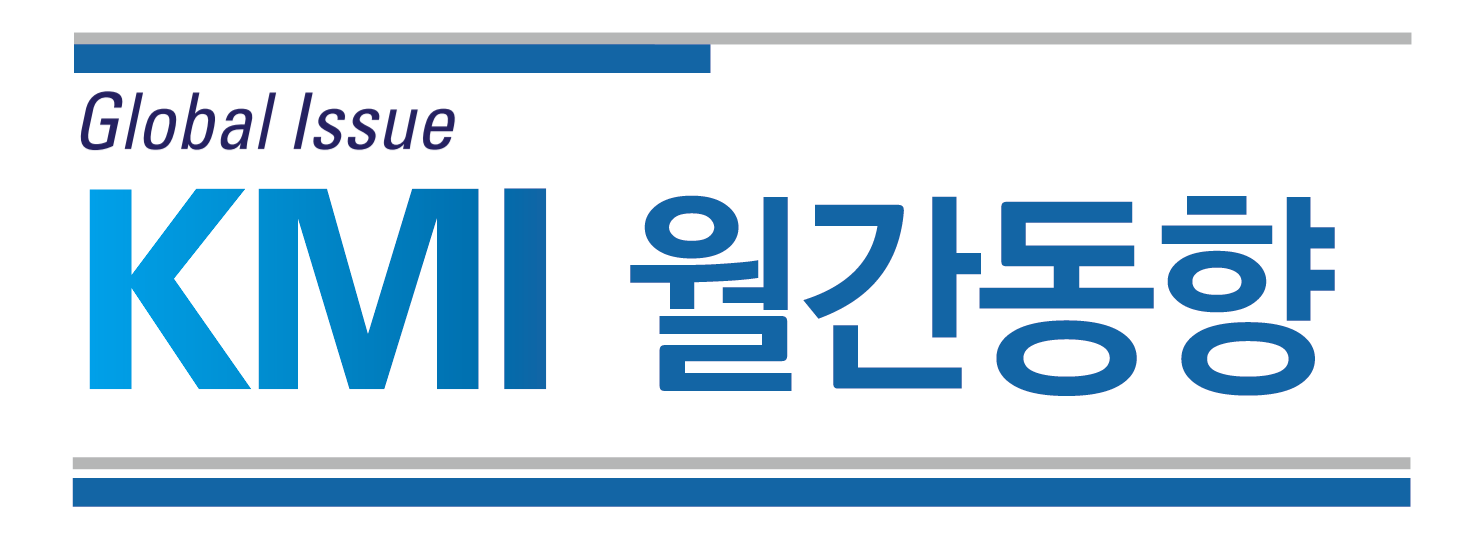-

- 메일앱이 동작하지 않는 경우

- Window 설정 > 앱 > 기본앱 > 메일에서 메일앱으로 변경
- [해운물류 > 해사안전연구실]2017-05-15 13:47:08/ 조회수 2852
-
K 라인의 LNG 추진선박 개발 프로젝트
- 평가덧글
- 인쇄보내기
- K 라인의 LNG 추진선박 개발 프로젝트
급격한 에너지 소비증가와 배기가스 배출 증가는 지구 온난화의 원인이 되고 있습니다. 더욱이 이러한 것은 해운산업에서 심각한 문제가 되고 있는 벙커 연료유에 대한 증가를 야기하고 있다.
이 문제를 극복하기 위해 K-Line은 가스 연료선박에 대한 연구 개발을 시작하여 세계 최초로 추진용으로 액화천연가스 (LNG)를 사용하고 있습니다.
LNG 추진선박의 도입은 대부분의 선박에서 사용되고 있는 화석연료의 사용에 따른 이산화탄소, 질소산화물, 황산화물 및 입자상물질 (PM)과 같은 대기오염 배출물의 의한 오염물질량을 급격히 감소시킬 수 있습니다.
K 라인의 LNG 추진선박의 경우, LNG로 전환하고 신기술을 도입함으로써 CO2 배출량을 약 40%, 질소산화물(NOx) 80-90 %, 황산화물(SOx) 및 미세먼지(PM)을 100% 줄일 수 있다고 주장하고 있습니다.
이 LNG 추진선박에 적용된 LNG탱크, 엔진, 추진시스템 및 축발전기에 대해 살펴보면,
LNG 연료탱크에는 2 개의 압력용기 (유형 C, 6)가 적용됩니다. 이 탱크는 엄격한 안전 기준을 준수해야한다. 따라서 탱크는 독립된 칸막이가 설치되고 충돌이나 다른 해양사고가 발생할 경우 안전을 보장하기 위해 선박의 외부 쉘과 바닥에서 일정한 거리에 위치하도록 하고 있습니다. 추가적인 안전조치로서 연료 파이프에 대해 강제로 이중 배관시스템을 적용하고 있습ㄴ다.
가스 엔진
연소를 사용하는 추진시스템으로 2 세트의 가스엔진 (각각 5,000kw)에 적용됩니다. 각 실린더는 메인 챔버에서 연소된 공기 - 가스 연료 혼합물과 함께 토치 제트 (toch jet)라고 불리는 점화용 불꽃을 발생시키는 점화 플러그가 있는 보조 챔버를 가지고 있습니다.
추진 시스템
가스엔진의 출력은 특수 감속기어로 결합되어 하나의 제어 가능 피치 프로펠러 (CPP)로 전달됩니다.
축발전기
감속기에 의해 2 세트의 축발전기가 설치 및 구동됩니다. 이 클러치 기어에 의해 분리할 수 있으며 항해 중에 모든 전력수요는 하나의 축발전기에 의해 커버될 수 있습니다. 조종 상태에서 2개의 축발전기를 병렬운전하면 스러스터와 다른 장비를 구동하기에 충분한 전략을 공급해야합니다.
https://www.kline.co.jp/en/pdf/csr/action_LNG_e.pdf
K line's Gas-Fuelled Ship Development Project
Energy consumption in increasing rapidly due to the growth of global population, and the increasing exhaust gas emissions are causing global warming. Moreover, this is causing a price increase for bunker fuel oil which is becoming a serious problem in the marine shipping industry.
In order to overcome these issues, K Line started research and development on Gas-fuelled ships, making it the first car carrier in the world to use liquefied natural gas(LNG) for propulsion.
Presently, propulsion of most ships is powered source for ships, pollutants in emissions such as carbon dioxide(CO2), nitrogen oxides(NOx), sulfur oxides(SOx) and particulate matter (PM) can be drastically reduced. K line has been a pioneer in the maritime shipping industry and is now tackling the challenges of developing LNG fuel technology.
compared to the use of heavy fuel oil, by switching to LNG and adopting new technologies, CO2 emissions can be reduced by approximately 40%, NOx by 80% to 90%, Sox and PM by 100%.
LNG Tanks
Two pressure vessels (type C, 6 bars) are applied for LNG fuel tanks. These tanks shall be required to comply with strict safety standards. Therefore, the tanks are installed in an independent compartment and located a certain distance from the ship's outer shell and bottom to ensure safety in the event of a collision or other marine incident. in addition, a complete double-wall piping system is applied for fuel pipes as a further safety measure.
Gas Engines
Two sets of Gas Engines (5,000kw each) are applied as propulsion system, employing lean burn combustion. Each cylinder has an auxiliary chamber with spark plug to generate a flame for ignition, which is called torch jet, with the air-gas fuel mixture being combusted in the main chamber.
Propulsion System
Output of the two gas engines is combined by a special reduction gear and transmitted to one controllable pitch propeller (CPP)
Shaft Generators
Two sets of shaft generators are installed and driven by the reduction gear. It is possible to disengage the gear by the clutch. During navigation, all electric power demand can be covered by one shaft generator. During maneuvering condition, parallel running of the two shaft generators is required to supply enough power to bow thruster and other equipment.
















